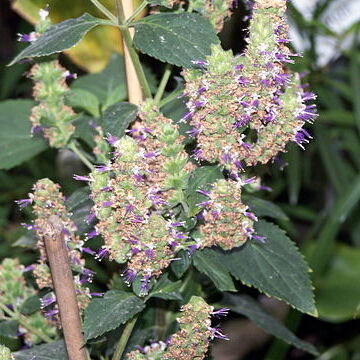Herbs or subshrubs, perennial, aromatic. Stems erect, 30-100 cm tall, tomentose. Petiole 1-6 cm; leaf blade circular to broadly ovate, 2-10.5 × 1-8.5 cm, herbaceous, adaxially dark green, sparsely tomentose, abaxially tomentose, base cuneate-attenuate, margin irregularly incised, apex obtuse to acute; lateral veins ca. 5-paired. Spikes 4-6.5 × 1.5-1.8 cm, densely tomentose, terminal and axillary; verticillasters 10-to many flowered, basally somewhat lax; peduncle 0.5-2 cm; bracts and bracteoles linear-lanceolate, somewhat shorter than to as long as calyx, densely tomentose. Calyx tubular, 7-9 mm, tomentose outside, minutely tomentose inside; teeth subulate-lanceolate, ca. 1/3 as long as calyx tube. Corolla purple, ca. 1 cm, lobes villous outside. Stamens bearded. Fl. Apr.
A herb or small shrub. It keeps growing from year to year. It has a smell. The stems are erect and 30-100 cm tall. The leaf stalk is 1-6 cm long. The leaf blade is almost round and 2-10.5 cm long by 1-8.5 cm wide. There are irregular teeth along the edge. There are many flowers. They are purple.

